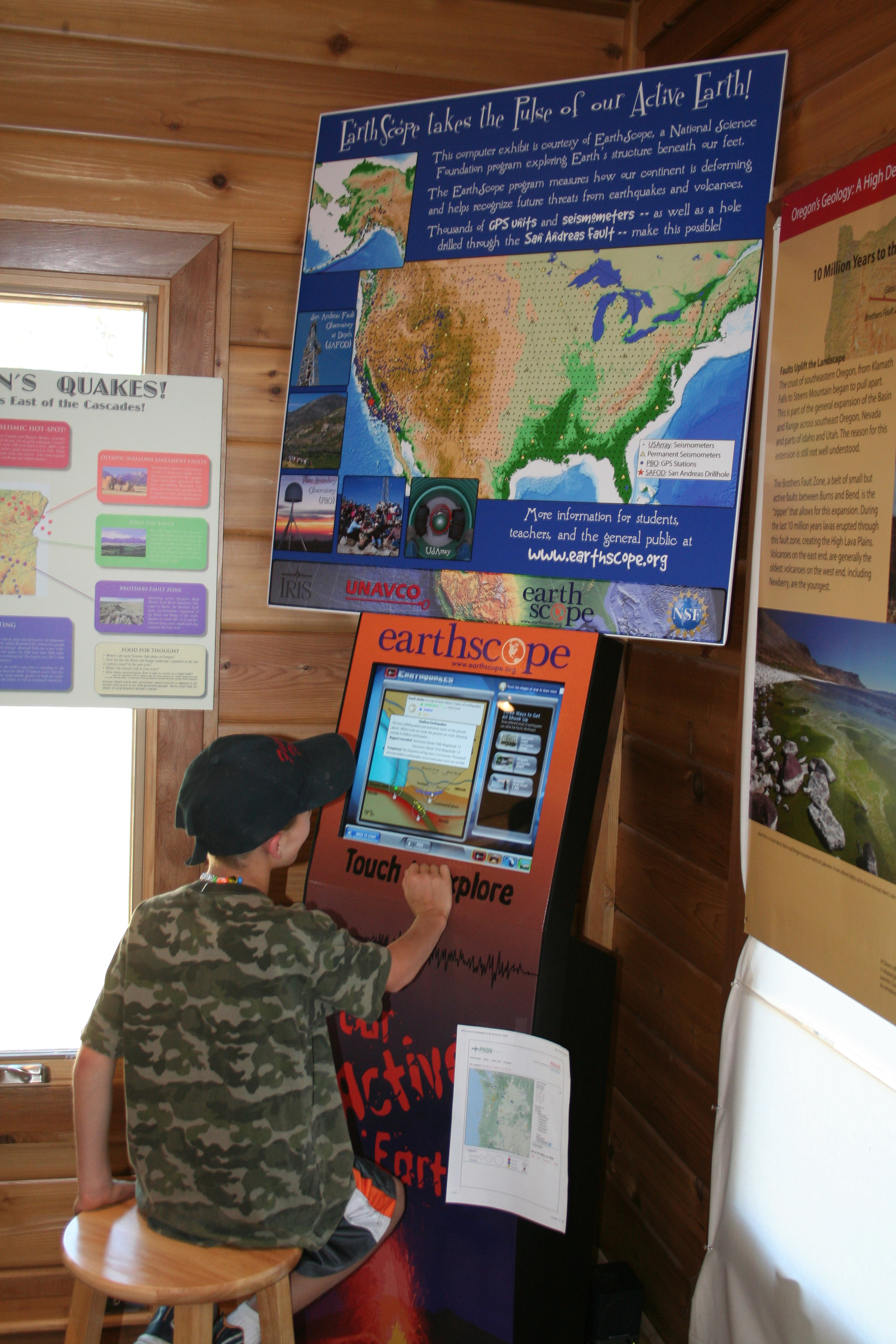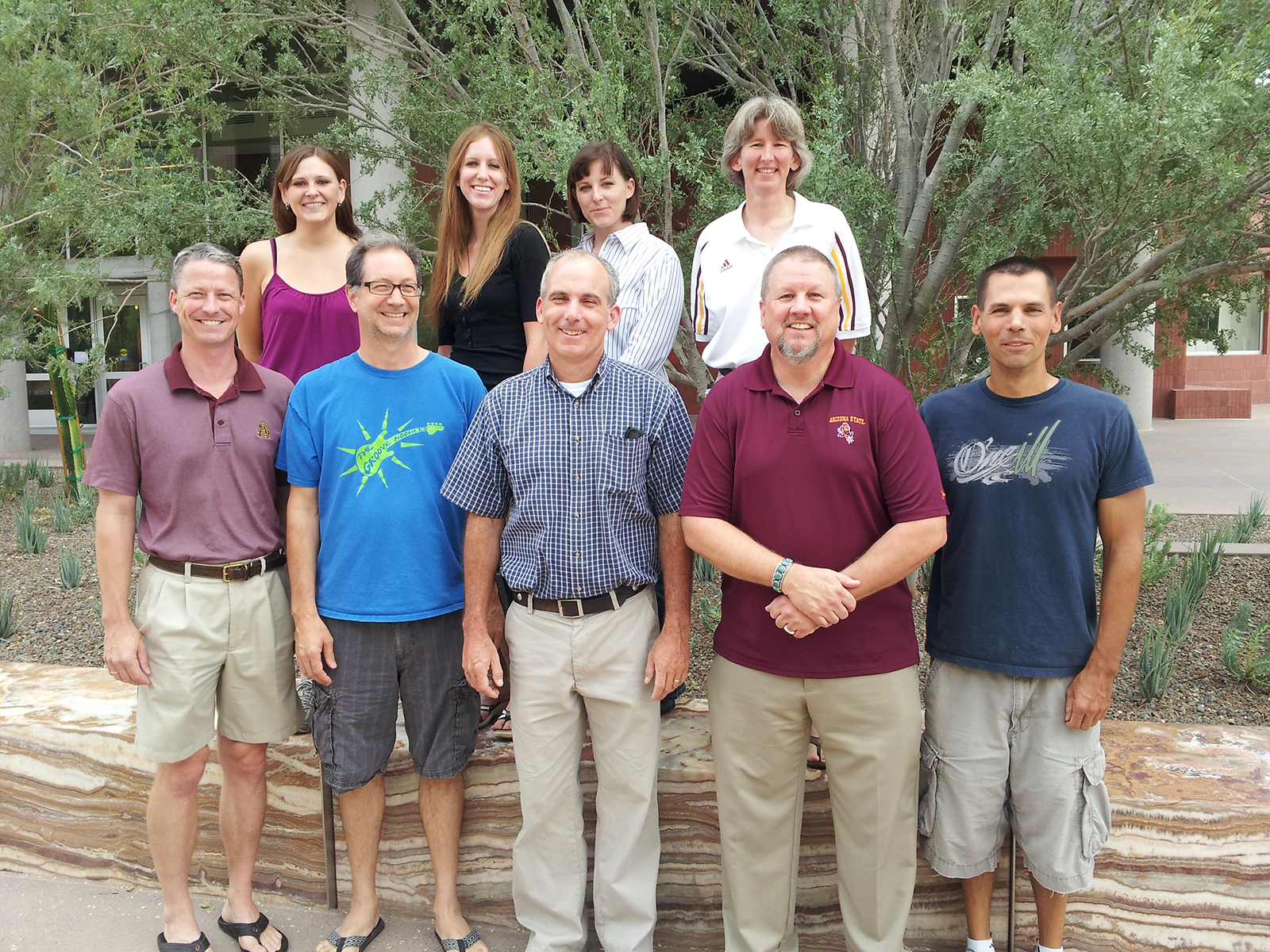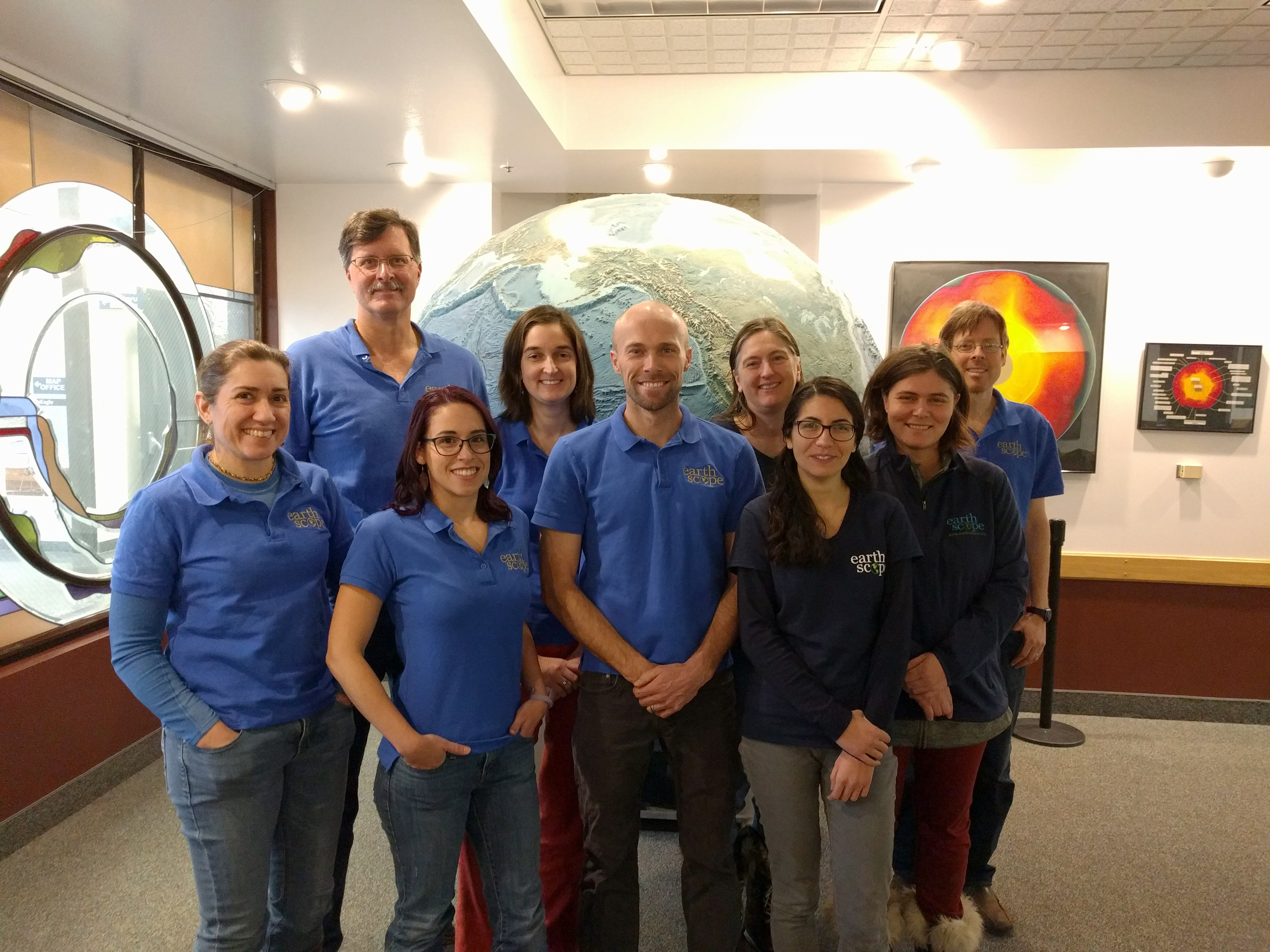By Jeff Freymueller, Ramon Arrowsmith, and Anne Tréhu
The EarthScope program at the National Science Foundation (NSF), the most ambitious earth science program NSF has funded, ran from 2003–2018, with the 15-year objective of investigating the structure and dynamics of the North American continent. EarthScope built a distributed facility of geophysical instruments deployed across the continent; funded scientific investigations that made use of that facility and other data; supported education, public outreach, and engagement; and developed a cohesive, multi-disciplinary scientific community. All EarthScope data were available openly and immediately, and the large volume of high-quality open data transformed how we worked in our scientific fields.
The initial focus of the EarthScope program was on the construction of the distributed facility, and early in the program the education and outreach efforts were centered on the EarthScope Facility Office, which under the leadership of Greg van der Vink also coordinated the various groups building the facilities. The EarthScope Facility Office developed the initial EarthScope website (originally envisioned as a data portal for EarthScope data users), published hard-copy and online materials to represent the EarthScope program and bring EarthScope information to the public, and began the series of EarthScope National Meetings in 2005. As the EarthScope facilities construction phase approached completion in 2008, NSF decided to separate the education, outreach, and community engagement efforts from EarthScope facility operations, leading to the creation of a rotating EarthScope National Office (ESNO) independent of the EarthScope facilities.
The greater part of the EarthScope facilities were built and operated by two community-governed non-profits, IRIS (seismology) and UNAVCO (geodesy). Linkages between the seismological and geodetic communities grew over the course of the EarthScope program, but the ESNO had an important role of promoting and representing the whole, multi-disciplinary EarthScope community to scientists and the general public. Efforts by all of these parties have led to greater cohesion and a broader scientific focus.
The ESNO worked with an EarthScope Steering Committee to advise the Office and to bring community input to NSF. This happened in a formal way through the Steering Committee and its sub-committees, and also informally as the ESNO Directors were present at many meetings where they could represent the interests of the whole EarthScope community. The ESNO Director and Steering Committee advised NSF on numerous issues, helping to steer decisions about EarthScope-related topics large and small. One example of an important issue was advising NSF about decisions involving SAFOD after the failure of the downhole observatory instrumentation.
The Incarnations of the EarthScope National Office
Oregon State University 2007–2011
Director: Anne Tréhu
The first university-based ESNO was established at Oregon State University (OSU) in July, 2007. Anne Tréhu and Robert Lillie led the office, with invaluable contributions from Jochen Braunmiller, Charlotte Goddard, and Chris LeBoeuf at OSU and Brian Blackman at UNAVCO. Our focus was on the 3 Ps: Planning, Parks, and the Public. One of our initial tasks was to design a website. We solicited articles from the scientific community on a wide range of EarthScope-related news, striving for at least one new feature per month. We produced a quarterly newsletter mailed to a broad cross-section of the geology and geophysics academic and research community, and also made available online.
“Planning” entailed a workshop in October 2009 to develop an EarthScope science plan for 2010–2020, and publication of the plan “Unlocking the Secrets of the North American Continent” in February 2010. The ESNO organized EarthScope National Meetings in 2009 and 2011, and several topical workshops on themes including “The Spectrum of Fault Slip Behavior” and the “Lithosphere/Asthenosphere Boundary.” Presentations from all workshops were posted to the web to encourage post-workshop collaboration.
“Parks” workshops led by Bob Lillie were designed to provide employees of national and state parks insight into the impact of EarthScope on understanding the geodynamic setting of the parks. They were given an opportunity to develop tools to incorporate this knowledge into their programs. The first workshop focused on the Cascadia subduction zone. Other workshops addressed the San Andreas fault, the Basin and Range region of the western U.S., the Rio Grande Rift, and the Yellowstone/Snake River Plain where the Yellowstone hotspot is located.
Arizona State University 2011–2015
Director: Ramon Arrowsmith
(Photo above: Arizona State University EarthScope staff: (Front row, left to right) Matt Fouch, Co-Principal Investigator; Ed Garnero, Co-Principal Investigator; Ramon Arrowsmith, Director; Steve Semken, Co-Principal Investigator; Patrick Schwab, Educational Assessment specialist. (Back row, left to right) Leah Pettis, undergraduate student worker; Sarah Robinson, Education and Outreach Manager; Devon Baumback, Media Specialist; Cindy Dick, Program Manager. Not pictured: Wendy Bohon, Bibliography and Social Media Specialist; Javier Colunga, IT support.)
The Arizona State University (ASU) ESNO helped to catalyze and maintain EarthScope’s cutting-edge geoscience research. Adding the ESNO director to the science steering committee, fostering partnerships with the EarthScope facilities, and engaging with earth scientists allowed us to better coordinate and communicate EarthScope’s scientific efforts. This included media engagement through press releases, local coverage for regional and global earthquakes (including the Mineral, Virginia event), and other availability as needed. Along with the facilities, we organized the EarthScope Decadal Symposium 2014 meeting in Washington D.C. with congressional staffers and hundreds of EarthScope researchers, educators, leaders, and stakeholders. We also coordinated the EarthScope National meeting in 2015 in Stowe, Vermont. The ASU EarthScope National Office broadened the impact of EarthScope science through education and outreach at many levels, organizing and executing numerous workshops and special sessions and via enhanced cyber-infrastructure. We focused on creating and sharing place-based earth science educational tools based on EarthScope data and discoveries. We updated the Earthscope website. We provided leadership in the use of social media for scientific organizations. We maintained the effective EarthScope Interpretive Workshops, the EarthScope Speakers series, and the quarterly newsletter inSights. Four Ph.D. students and five undergraduates at ASU were involved in the ESNO’s activities and were key members of the team with important responsibilities for social media, assessment, video production, and web design and support.
University of Alaska Fairbanks 2015–2019
Director: Jeff Freymueller
(Photo above: Current EarthScope staff: (Back row, left to right) Jeff Freymueller, Director; Elisabeth Nadin, Co-Principal Investigator; Jessica Larsen, Deputy Director; Carl Tape, Co-Principal Investigator. (Front row) Beth Grassi, Science Writer/Public Information Officer; Samantha Slease, Office Manager; David Fee, Co-Principal Investigator; Veselina Yakimova, Social Media Manager; Maite Agopian, Education and Outreach Coordinator.)
The ESNO moved to University of Alaska Fairbanks in 2015. By that time, the series of interpretive workshops organized by the previous offices had covered the entire country. With the EarthScope program approaching its end, we chose instead to focus on synthesis of EarthScope scientific results, developing an effective summary presentation of EarthScope science results, and continuing national outreach via electronic means. Our outreach efforts included updating and modernizing the EarthScope website and integrating the inSights newsletter with the website, continuing the successful social media campaign begun at ASU, and publicizing EarthScope science at meetings and other venues by reaching out to the media via press releases and the public via feature stories. We targeted educators by introducing an Education Corner article in each issue of inSights, with contributions from both IRIS and UNAVCO.
The ESNO convened a total of 10 Synthesis workshops, on topics proposed by the scientific community. Many of the workshops focused on regionally based synthesis, covering the Mendocino Triple Junction, the southern margin of North America, the southern Appalachians, Cascadia, the Midcontinent Rift, and the Wyoming Craton. Others were topic-driven: the San Andreas Fault Observatory at Depth (SAFOD), tools for and applications of hydrogeodesy, and the 4D evolution of North America. These workshops facilitated synthesis or overview publications, special issues of journals, sessions at meetings, and new research collaborations. They inspired ESNO feature and scientist profile stories for the web and inSights, a virtual field trip, and other outreach materials. We organized the final EarthScope National Meeting in 2017, which focused on synthesis of EarthScope science, and attracted a substantial delegation from China who wanted to learn how EarthScope approached interdisciplinary science.
We have also put significant effort into compiling a more complete bibliography of EarthScope science, which is difficult as many scientists use EarthScope data but do not specifically highlight that fact, and because the reach of EarthScope science has been so broad. We integrated the historical bibliography developed by the previous offices with compilations made by UNAVCO and IRIS, and worked to fill in the gaps between these efforts. Recently, we added publications compiled independently by the SAFOD community, as well as publications in educational journals. We are in the process of making this into an annotated bibliography that includes brief summaries of the highest-impact papers. In its final months, the final ESNO will showcase EarthScope achievements, including an interactive map of EarthScope results (Science Nuggets) and a Top 10 EarthScope Discoveries list compiled by the community, at national events.
The EarthScope Legacy
EarthScope information will continue to be available on the website after the office closes, including the Science Nuggets interactive online map featuring summaries of EarthScope projects across the continent. The Science Nuggets are included in the Flyover Country app, which allows travelers to explore geoscience-related sites on or offline.
Whenever a synoptic perspective was needed, the ESNOs were effective in reaching out to and organizing a broad scientific community. The offices worked cooperatively with the EarthScope facilities to encourage multi-disciplinary science with broad community participation.
The EarthScope facilities have left their mark as well. Significant numbers of the USArray Transportable Array seismic stations were adopted by state and local agencies, and have resulted in permanent improvements in seismic monitoring in the Pacific Northwest, Utah, the Central and Eastern U.S., and Alaska. Most of the Plate Boundary Observatory geodetic network will remain operational for the next decade as part of the Network of the Americas. EarthScope has helped to prove the scientific value of long-term geodetic measurements for a wide range of earth science and environmental applications.
The open EarthScope data will continue to be available for decades to come. The model of open data in large quantities has supported generations of geoscientists from undergraduates and into careers, changing the perspective on the scope of questions open to research.
EarthScope’s success has inspired similar integrative geophysical programs in Europe, China, Australia/New Zealand, and one currently developing in Canada.
This spring, the ESNO invites you to help us celebrate EarthScope’s 15 years of exploration through events in Washington, D.C. in May: a finale science symposium and reception on May 22 for the EarthScope community in conjunction with a luncheon for Congressional staff. Details for the symposium and reception will be posted soon on the Events calendar on the EarthScope website.
EarthScope would not have been possible without the participation of the entire community. On behalf of all of the ESNO participants, we would like to thank our entire audience for your creativity, insight, and dedication to expanding knowledge of the geosciences. As a community, we found answers we didn’t even know we were looking for. We hope that the legacy of EarthScope is continually expanding inquiry and multidisciplinary cooperation.








